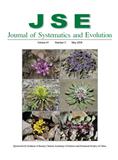Dmitry A GERMAN, Wen-Li CHEN
A critical revision of the collections of Brassicaceae in some Chinese (PE, XJA, XJBI, XJFA, XJNM, XJU) and foreign (LE, P) herbaria is made. One genus, Neurotropis (DC.) F. K. Mey., and 11 species, Alyssum szarabiacum Nyár., Barbarea stricta Andrz., Erysimum czernjajevii N. Busch, Erysimum kotuchovii D. German, Erysimum mongolicum D. German, Lepidium karelinianum Al-Shehbaz, Matthiola superba Conti, Neurotropis platycarpa (Fisch. & Mey.) F. K. Mey., Ptilotrichum dahuricum Peschkova, Sisymbrium subspinescens Bunge, and Smelowskia micrantha (Botsch. & Vved.) Al-Shehbaz & S. I. Warwick, are reported from China for the first time. Six species, Aphragmus involucratus (Bunge) O. E. Schulz, Dontostemon perennis C. A. Mey., Goldbachia torulosa DC., Lepidium amplexicaule Willd., Neotorularia brevipes (Kar. & Kir.) Hedge & J. Léonard, and Parrya stenocarpa Kar. & Kir., are confirmed to occurr in China. Five species, Dontostemon integrifolius (L.) C. A. Mey., Draba zangbeiensis L. L. Lou, Lepidium alashanicum H. L. Yang, Sinapis arvensis L., and Strigosella brevipes (Bunge) Botsch., are reported as novelties for some provinces in China, and Strigosella hispida (Litv.) Botsch. occurs in Xinjiang, China. However, the occurrence of one genus, Pseudoarabidopsis Al-Shehbaz, O'Kane & Price, and four species, Draba huetii Boiss., Eutrema halophilum (C. A. Mey.) Al-Shehbaz & S. I. Warwick, Galitzkya spathulata (Steph. ex Willd.) V. Bocz., and Pseudoarabidopsis toxophylla (Bieb.) Al-Shehbaz, O'Kane & Price, could not be confirmed in China. The occurrence of six species, Aphragmus bouffordii Al-Shehbaz, Barbarea orthoceras Ledeb., Lepidium latifolium L., Ptilotrichum canescens (DC.) C. A. Mey., Strigosella hispida (Litv.) Botsch., and Strigosella scorpioides (Bunge) Botsch., is not confirmed in certain provinces of China. All names follow the latest taxonomic treatment for relevant groups; detailed morphological descriptions of the newly recorded taxa are provided; and distinguishing characters from related species already known in China are discussed. Other comments are provided where needed.

